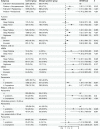Association of Parasomnia Symptoms with Risk of Childhood Asthma and the Role of Preterm Birth
- PMID: 36089999
- PMCID: PMC9451036
- DOI: 10.2147/NSS.S356182
Association of Parasomnia Symptoms with Risk of Childhood Asthma and the Role of Preterm Birth
Abstract
Purpose: To examine whether parasomnia symptoms are associated with increased odds of childhood asthma and wheeze, and the role of preterm birth.
Patients and methods: The Shanghai Children's Allergy Study was cross-sectionally conducted in 31 kindergartens and 17 primary schools in Shanghai, China. After excluding the missing data of gestational week and child's age, this study included a total of 16,487 individuals with a mean age of 7.74 years and 52.4% of males. The association between parasomnia symptoms and wheeze/asthma was assessed by univariate and multivariate analyses. The interaction effects of parasomnias and preterm birth were primarily evaluated by P for multiplicative interaction, and the relative excess risk due to interaction (RERI), attributable proportion due to interaction (AP), and synergy index (SI) were also measured.
Results: Parasomnias, especially rapid eye movement (REM) parasomnia symptoms, were associated with an increased risk of childhood wheeze/asthma, and the interaction between parasomnia and preterm birth exhibited an excess risk of current wheeze (RERI, 1.43; 95% CI, 0.41-2.45) and ever asthma (RERI, 0.75; 95% CI, 0.01-1.50). In the stratification analyses, the combination of parasomnia symptoms and preterm birth had higher odds of wheeze/asthma. And the odds of current wheeze (OR, 4.55; 95% CI, 1.69-12.25; p=0.003) and ever asthma (OR, 6.17; 95% CI, 2.36-16.11; p<0.001) were much higher in cumulative parasomnia symptoms plus very preterm birth. And sensitive analyses were further conducted in populations without sleep disordered breathing (SDB), and an allergen test subgroup, yielding similar results.
Conclusion: Parasomnia symptoms are associated with increased odds of childhood wheeze/asthma, and the odds were even higher in premature population. The findings suggest that parasomnia symptoms, as a developmental sleep disorder, are supposed to be closely watched among children who have asthma or are at risk for asthma, and that preterm children deserve more attention.
Keywords: premature; respiratory allergies; sleep; sleep disorders.
© 2022 Chen et al.
Conflict of interest statement
The authors report no conflicts of interest in this work.
Figures



Similar articles
-
Sleepwalking and sleep terrors in prepubertal children: what triggers them?Pediatrics. 2003 Jan;111(1):e17-25. doi: 10.1542/peds.111.1.e17. Pediatrics. 2003. PMID: 12509590
-
A population-based study exploring association of parasomnia symptoms with sleep onset delay among school-aged children.Sleep Med. 2024 May;117:1-8. doi: 10.1016/j.sleep.2024.02.010. Epub 2024 Feb 2. Sleep Med. 2024. PMID: 38460489
-
Early-Life Weight Status and Risk of Childhood Asthma or Recurrent Wheeze in Preterm and Term Offspring.J Allergy Clin Immunol Pract. 2023 Jul;11(7):2125-2132.e1. doi: 10.1016/j.jaip.2023.03.059. Epub 2023 Apr 23. J Allergy Clin Immunol Pract. 2023. PMID: 37088369 Free PMC article.
-
A parasomnia overlap disorder involving sleepwalking, sleep terrors, and REM sleep behavior disorder in 33 polysomnographically confirmed cases.Sleep. 1997 Nov;20(11):972-81. doi: 10.1093/sleep/20.11.972. Sleep. 1997. PMID: 9456462 Review.
-
Epidemiology of asthma and recurrent wheeze in childhood.Clin Rev Allergy Immunol. 2002 Feb;22(1):33-44. doi: 10.1007/s12016-002-0004-z. Clin Rev Allergy Immunol. 2002. PMID: 11803801 Review.
Cited by
-
Use of feature importance statistics to accurately predict asthma attacks using machine learning: A cross-sectional cohort study of the US population.PLoS One. 2023 Nov 22;18(11):e0288903. doi: 10.1371/journal.pone.0288903. eCollection 2023. PLoS One. 2023. PMID: 37992024 Free PMC article.
-
The Joint Association of Sleep Quality and Outdoor Activity with Asthma and Allergic Rhinitis in Children: A Cross-Sectional Study in Shanghai.J Asthma Allergy. 2025 Feb 4;18:101-111. doi: 10.2147/JAA.S494662. eCollection 2025. J Asthma Allergy. 2025. PMID: 39931536 Free PMC article.
References
-
- Zadra A, Pilon M. NREM parasomnias - ScienceDirect. Handb Clin Neurol. 2011;99:851–868. - PubMed
LinkOut - more resources
Full Text Sources

